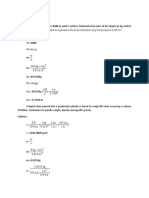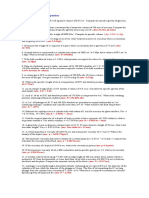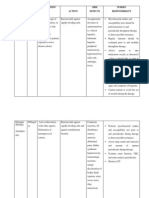Fluid Mechanics
Uploaded by
cate canlasFluid Mechanics
Uploaded by
cate canlasFLUID MECHANICS Calculate the velocity gradient and the intensity of
1. Calculate the specific weight γ , specific volume v s, shear stress at the boundary and at points 1 in, 2 in,
and density p, of methane at 100 ° F and 120 psi and 3 in from the boundary, assuming
(a) A straight – line velocity distribution.
ft
absolute. R=96.3 . (b) A parabolic velocity distribution. The parabola in
°R the sketch has its vertex at A. Origin is at B.
2. If 6 m 3 of oil weighs 47 kN , calculate its specific
weight γ , density p , and specific gravity.
3. At 90 ° F and 30.0 psi absolute the volume per unit
3
weight of a certain gas was 11.4
ft . Determine its
lb
gas constant R and the density p. 12. A reservoir of glycerin (glyc) has a mass of 1200kg
4. (a) Find the change in volume of 1.00 ft 3 of water at and a volume of 0.952 m 3. Find the glycerin’s
80 ° F when subjected to a pressure increase of 300 weight ( W ), mass density ( p ) , specific weight ( y ) ,
psi. and specific gravity (s.g.).
(b) From the following test data determine the bulk
modulus of elasticity of water: at 500 psi the volume 13. A body requires a force of 100N to accelerate it at a
was 1.000 ft 3 , and at 3500 psi the volume was m
3 rate of 0.20 2 . Determine the mass of the body in
0.990 . E=325,000 psi s
5. At a great depth in the ocean, the pressure is 80 MPa. kilograms and in slugs.
kN 14. A reservoir of carbon tetrachloride (CCL) has a mass
Assume that specific weight at the surface is 10 3
m of 500kg and a volume of 0.315 m 3. Find the carbon
and the average bulk modulus of elasticity is 2.340 tetrachloride’s weight, mass density, specific weight,
GPa. Find: and specific gravity.
(a) the change in specific volume between the 15. The weight of a body is 100 lb. Determime:
surface and that great depth. (a) Its weight in newtons
(b) the specific volume at that depth. (b) Its mass in kilogram
(c) the specific weight at that depth (c) The rate of acceleration [in both feet per second
6. A cylinder contains 12.5 ft 3 of air at 120 ° F and 40
psi absolute. The air is compressed to 2.50 ft . 3 ( sft )
2 and meters per second
( ms )
2 if a net force
(a) Assuming isothemal conditions, what is the of 50 lb is applied to the body.
pressure at the new volume, and what is the bulk 16. The specific gravity of ethyl alcohol is 0.79.
modulus of elasticity? Calculate its specific weight (in both pounds per
(b) Assuming adiabatic conditions, what is the final cubic foot and kilograms per cubic meter).
pressure and temperature, and what is the bulk 17. One cubic foot of glycerin has a mass of 2.44 slugs.
modulus of elasticity? Find its specific weight in both pounds per cubic foot
7. From the International Critical Tables, the viscosity and kilonewtons per cubic meter.
of water at 20 ° C ( 68 ° F ) is 1.008 cp (centipoises). 18. A quart of SAE 30 oil at 68 ° F weighs about 1.85
lb−sec lb. Calculate the oil’s specific weight, mass density,
(a) Compute the absolute viscosity in 2 . and specific gravity.
ft
(b) If the specific gravity at 20 ° C is 0.998, 19. The volume of a rock is found to be 0.00015 m 3. If
2 the rock’s specific gravity 2.60, what is its weight?
ft .
compute the kinematic viscosity in lb
sec 20. A certain gasoline weighs 46.5 3 . What are its
2 ft
8. Convert 15.14 poises to
ft if the liquid has specific mass density, specific volume, and specific gravity?
sec kN
gravity 0.964. 21. If the specific weight of a substance is 8.2 3 , what
9. Convert a kinematic viscosity of 510 Saybolt seconds m
2 is its mass density?
at 60 ° F to
ft . 22. An object at a certain location has a mass of 2.0kg
sec and weighs 19.0 N on a spring balance. What is the
10. Discuss the shear characteristics of the fluids for acceleration due to gravity at this location?
which the curves have been drawn in Fig. 1-3. 23. If an object has a mass of 2.0 slugs at sea level, what
would its mass be at a location where the acceleration
ft
due to gravity is 30.00 2?
s
24. What would be the weight of a 3-kg mass on a planet
m
where the acceleration due to gravity is 10.00 2?
s
25. Determine the weight of a 5-slug boulder at a place
ft
11. Refer to Fig. 1-4. A fluid has absolute viscosity where the acceleration due to gravity is 31.7 2?
lb−sec s
0.0010 2 and specific gravity 0.913. 26. If 200 ft 3 of oil weights 10,520 lb, calculate its
ft specific weight, density, and specific gravity.
27. Find the height of the free surface if 0.8 ft 3 of water
is poured into a conical tank (Fig. 1-1) 20 in high
with a vase radius of 10 in. How much additional
water is required to fill the tank?
28. If the tank of Prob 27 holds 30.5kg of salad oil, what
is the density of the oil?
29. Under standard conditions a certain gas weighs
lb
0.14 3 . Calculate its density, specific volume, and
ft
lb
specific gravity relative to air weighing 0.075 3 .
ft
3
30. If the specific volume of a gas is 360
ft , what is
slug
its specific weight?
31. A vertical glass cylinder contains 900.00mL of water
at 10 ° C ; the height of the water column is 90.00cm.
The water and its container are heated to 80 ° C .
Assuming no evaporation, what will be the height of
the water if the coefficient of thermal expansion ( α )
for the glass is 3.6 ×10−6 ° C−1?
32. If a vessel that contains 3.500 ft 3 of water at 50 ° F
and atmospheric pressure is heated to 160 ° F , what
will be the percentage change in its volume? What
weight of water must be removed to maintain the
original volume?
33. A vertical, cylindrical tank with a diameter of
12.00mm and a depth of 4.00m is filled to the top
with water at 20 ° C . If the water is heated to 50 ° C ,
how much water will spill over?
34. A thick, closed, steel chamber is filled with water at
50 ° F and atmospheric pressure. If the temperature
of water and chamber is raised to 100 ° F , find the
new pressure of the water. The coefficient of thermal
expansion of steel is 6.5 ×10−6 per ° F .
35. A liquid compressed in a cylinder has a volume of
MN
1000 cm at 1
3 3
2 and a volume of 995 cm at
m
MN
2 2 . What is its bulk modulus of elasticity ( K ) ?
m
36. Find the bulk modulus of elasticity of a liquid if a
pressure of 150 psi applied to 10 ft 3 of the liquid
causes a volume reduction of 0.02 ft 3 .
37. If K=2.2GPa is the bulk modulus of elasticity for
water, what pressure is required to reduce a volume
by 0.6 percent?
38. Find the change in volume of 1.00000 ft 3 of water
at 80 ° F when subjected to a pressure increase of
300 psi. Water’s bulk modulus of elasticity at this
temperature is 325,000 psi.
39. From the following test data, determine the bulk
modulus of elasticity of water; at 500 psi the volume
was 1.000 ft 3 , and at 3500 psi the volume was
3
0.990 ft .
You might also like
- Fluid Mechanics With Engineering Applications75% (8)Fluid Mechanics With Engineering Applications621 pages
- 1. Ce0009 - Fluid Mechanics (Lec) - Problem Set # 1No ratings yet1. Ce0009 - Fluid Mechanics (Lec) - Problem Set # 12 pages
- Solved Problems in Fluid Mechanics-Chapter 1 - Fluid Properties100% (3)Solved Problems in Fluid Mechanics-Chapter 1 - Fluid Properties24 pages
- Cueto, Renthel R (Answers To Problem Set 1 On Fluid Mechanics)100% (2)Cueto, Renthel R (Answers To Problem Set 1 On Fluid Mechanics)21 pages
- Fluid Mechanics Assignment 2: Answers With Decimals Must Be Corrected To Two Decimal PlacesNo ratings yetFluid Mechanics Assignment 2: Answers With Decimals Must Be Corrected To Two Decimal Places1 page
- Ce Correl Fluid Mechanics (A) : Situation 1No ratings yetCe Correl Fluid Mechanics (A) : Situation 12 pages
- Finnemore_Solutions_11e_Chapter_02-Exercise SolutionsNo ratings yetFinnemore_Solutions_11e_Chapter_02-Exercise Solutions15 pages
- Fluid Mechanics With Engineering Applica PDF100% (1)Fluid Mechanics With Engineering Applica PDF621 pages
- MEC 241 Tutorial 1-Introduction and Basic ConceptsNo ratings yetMEC 241 Tutorial 1-Introduction and Basic Concepts2 pages
- Vdocuments - MX - Problems On Fluid Properties PDFNo ratings yetVdocuments - MX - Problems On Fluid Properties PDF1 page
- FLUID-I-CH 1 Introduction Properties Tut 1No ratings yetFLUID-I-CH 1 Introduction Properties Tut 14 pages
- Yi Tian Tu Long Ji: (Heavenly Sword Dragon Slaying Saber)No ratings yetYi Tian Tu Long Ji: (Heavenly Sword Dragon Slaying Saber)293 pages
- Fall 2016 PSAT Test Practice Test 2 Reading Writing and Language TestsNo ratings yetFall 2016 PSAT Test Practice Test 2 Reading Writing and Language Tests40 pages
- Factors Affecting Interests in LiteratureNo ratings yetFactors Affecting Interests in Literature3 pages
- ENGINEERING 3014 Engineering ChemistrySummerNo ratings yetENGINEERING 3014 Engineering ChemistrySummer2 pages
- 01 Introduction To The Book of Daniel - 1No ratings yet01 Introduction To The Book of Daniel - 150 pages
- Third Quarter Consolidated Grades: General AverageNo ratings yetThird Quarter Consolidated Grades: General Average4 pages
- What Is Your Name? How Old Are You? Where Are You From?No ratings yetWhat Is Your Name? How Old Are You? Where Are You From?37 pages
- Student Exploration: Roller Coaster PhysicsNo ratings yetStudent Exploration: Roller Coaster Physics3 pages
- Income Statement Comparison For The 2 Periods Ended 2/24/2019 Rowes IGANo ratings yetIncome Statement Comparison For The 2 Periods Ended 2/24/2019 Rowes IGA2 pages

























































































